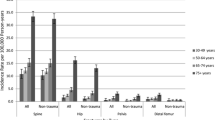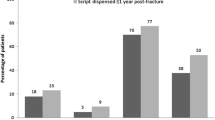Abstract
The burden of osteoporotic fractures in older men is significant. The objectives of our study were to: (1) characterize older men with fractures associated with osteoporosis, (2) determine if medication treatment rates for osteoporosis are improving and (3) identify patient, healthcare benefit and utilization, and clinician characteristics that are significantly associated with treatment. This retrospective cohort study assessed 1,171 men aged 65 or older with any new fracture associated with osteoporosis between 1 January 1998 and 30 June 2001 in a non-profit health maintenance organization in the United States. Multiple logistic regression was used to evaluate pre-fracture factors for their association with osteoporosis treatment in the 6-month post-fracture period. The main outcome measure was pharmacologic treatment for osteoporosis in the 6 months after the index fracture. Subjects’ average age was 76.7 years; 3.3% had a diagnosis of osteoporosis and 15.2% a diagnosis or medication associated with secondary osteoporosis. Only 7.1% of the study population and 16.0% of those with a hip or vertebral fracture received a medication for osteoporosis following the index fracture, and treatment rates did not improve over time. In the multivariate model, factors significantly associated with drug treatment were a higher value on the Charlson Comorbidity Index (odds ratio 1.26, 95% confidence interval 1.05–1.51), having an osteoporosis diagnosis (odds ratio 8.11, 95% confidence interval 3.08–21.3), chronic glucocorticoid use (odds ratio 5.37, 95% confidence interval 2.37–12.2) and a vertebral fracture (odds ratio 16.6, 95% confidence interval 7.8–31.4). Bone mineral density measurement was rare ( n =13, 1.1%). Our findings suggest that there is under-ascertainment and under-treatment of osteoporosis and modifiable secondary causes in older men with fractures. Information systems merging diagnostic and treatment information can help delineate gaps in patient management. Interventions showing promise in other conditions should be evaluated to improve care for osteoporosis.


Similar content being viewed by others
References
Cooper C, Campion G, Melton LJ III (1992) Hip fractures in the elderly: a world-wide projection. Osteoporos Int 2:285–289
Center JR, Nguyen TV, Schneider D, Sambrook PN, Eisman JA (1999) Mortality after all major types of osteoporotic fracture in men and women: an observational study. Lancet 353:878–882
Ross PD (1996) Osteoporosis. Frequency, consequences, and risk factors. Arch Intern Med 156:1399–1411
Cummings SR, Melton LJ (2002) Epidemiology and outcomes of osteoporotic fractures. Lancet 359:1761–1767
Lips P (1997) Epidemiology and predictors of fractures associated with osteoporosis. Am J Med 103:3S–8S
Tuck SP, Raj N, Summers GD (2002) Is distal forearm fracture in men due to osteoporosis? Osteoporos Int 13:630–636
Office of Technology Assessment (1994) Hip fracture outcomes in people age fifty and over: background paper. OTA-BP-H-120. US Congress, Office of Technology Assessment, Washington, DC
Poor G, Atkinson EJ, Lewallen DG, O’Fallon WM, Melton LJ III (1995) Age-related hip fractures in men: clinical spectrum and short-term outcomes. Osteoporos Int 5:419–426
Kiebzak GM, Beinart GA, Perser K, Ambrose CG, Siff SJ, Heggeness MH (2002) Undertreatment of osteoporosis in men with hip fracture. Arch Intern Med 162:2217–2222
Ray NF, Chan JK, Thamer M, Melton LJ III (1997) Medical expenditures for the treatment of osteoporotic fractures in the United States in 1995: report from the National Osteoporosis Foundation. J Bone Miner Res 12:24–35
Colon-Emeric C, Yballe L, Sloane R, Pieper CF, Lyles KW (2000) Expert physician recommendations and current practice patterns for evaluating and treating men with osteoporotic hip fracture. J Am Geriatr Soc 48:1261–1263
Feldstein AF, Elmer PJ, Orwoll E, Herson M, Hillier T (2003) Bone mineral density measurement and treatment for osteoporosis in older individuals with fractures: A gap in evidence-based practice guideline. Arch Intern Med 163:2165–2172
Feldstein AF, Nichols GA, Elmer PJ, Smith DH, Aickin M, Herson M (in press) Older women with fractures: patient characteristics and trends in bone mineral density measurement and treatment for osteoporosis. J Bone Joint Surg
Osteoporosis Task Force (1996) AACE (American Association of Clinical Endocrinologists) clinical practice guidelines for the prevention and treatment of postmenopausal osteoporosis. Endocr Pract 2:155-171
National Osteoporosis Foundation (2000) Physicians guide to prevention and treatment of osteoporosis. National Osteoporosis Foundation, Washington, DC
American College of Rheumatology Task Force on Osteoporosis Guidelines (1996) Recommendations for the prevention and treatment of glucocorticoid-induced osteoporosis. Arthritis Rheum 39:1791–1801
Kanis JA, Delmas P, Burckhardt P, Cooper C, Torgerson D (1997) Guidelines for diagnosis and management of osteoporosis. The European Foundation for Osteoporosis and Bone Disease. Osteoporos Int 7:390–406
American College of Rheumatology Ad Hoc Committee on Glucocoritcoid-Induced Osteoporosis (2001) Recommendations for the prevention and treatment of glucocorticoid-induced osteoporosis: 2001 update. Arthritis Rheum 44:1496–1503
National Osteoporosis Foundation (1998) Osteoporosis: Review of the evidence for prevention, diagnosis, and treatment and cost-effectiveness analysis. Executive summary. Osteoporos Int [Suppl] 4:S3–S6
Seeley DG, Browner WS, Nevitt MC, Genant HK, Scott JC, Cummings SR (1991) Which fractures are associated with low appendicular bone mass in elderly women? The Study of Osteoporotic Fractures Research Group. Ann Intern Med 115:837–842
Tinetti ME, Speechley M, Ginter SF (1988) Risk factors for falls among elderly persons living in the community. N Engl J Med 319:1701–1707
Charlson ME, Pompei P, Ales KL, MacKenzie CR (1987) A new method of classifying prognostic comorbidity in longitudinal studies: Development and validation. J Chron Dis 40:373–383
Deyo RA, Cherkin DC, Ciol MA (1992) Adapting a clinical comorbidity index for use with ICD-9-CM administrative databases. J Clin Epidemiol 45:613–619
Favus MJ (ed) (1999) Primer on the metabolic bone diseases and disorders of mineral metabolism. Lippincott Williams and Wilkins, Philadelphia
Kamel HK, Hussain MS, Tariq S, Perry HM, Morley JE (2000) Failure to diagnose and treat osteoporosis in elderly patients hospitalized with hip fracture. Am J Med 109:326–328
Juby AG, Geus-Wenceslau CM (2002) Evaluation of osteoporosis treatment in seniors after hip fracture. Osteoporos Int 13:205–210
Broy S, Bohren A, Harrington T, Licata A, Shewman D (2000) Are physicians treating osteoporosis after hip fracture. 22nd Annual Meeting of the American Society for Bone and Mineral Research (ASBMR), 23–26 September 2000, AMSBMR, Toronto, Canada
Khan SA, de Geus C, Holroyd B, Russell AS (2001) Osteoporosis follow-up after wrist fractures following minor trauma. Arch Intern Med 161:1309–1312
Desai MM, Zhang P, Hennessy CH (1999) Surveillance for morbidity and mortality among older adults—United States, 1995–1996. MMWR CDC Surveill Summ 48:7–25
Forsen L, Sogaard AJ, Meyer HE, Edna T, Kopjar B (1999) Survival after hip fracture: short- and long-term excess mortality according to age and gender. Osteoporos Int 10:73–78
Melton LJ III, Crowson CS, O’Fallon WM (1999) Fracture incidence in Olmsted County, Minnesota: comparison of urban with rural rates and changes in urban rates over time. Osteoporos Int 9:29–37
Scane AC, Francis RM, Sutcliffe AM, Francis MJ, Rawlings DJ, Chapple CL (1999) Case-control study of the pathogenesis and sequelae of symptomatic vertebral fractures in men. Osteoporos Int 9:91–97
Pande I, O’Neill TW, Pritchard C, Scott DL, Woolf AD (2000) Bone mineral density, hip axis length and risk of hip fracture in men: results from the Cornwall Hip Fracture Study. Osteoporos Int 11:866–870
Nguyen TV, Eisman JA, Kelly PJ, Sambrook PN (1996) Risk factors for osteoporotic fractures in elderly men. Am J Epidemiol 144:255–263
Gardsell P, Johnell O, Nilsson BE (1990) The predictive value of forearm bone mineral content measurements in men. Bone 11:229–232
Klotzbuecher CM, Ross PD, Landsman PB, Abbott TA, III, Berger M (2000) Patients with prior fractures have an increased risk of future fractures: a summary of the literature and statistical synthesis. J Bone Miner Res 15:721–739
Orwoll E, Klein RF (1996) Osteoporosis in men. In: Marcus R, Feldman D, Kelsey J (eds) Osteoporosis. Academic Press, San Diego, pp 745–784
Orwoll E, Ettinger M, Weiss S, Miller P, Kendler D, Graham J et al (2000) Alendronate for the treatment of osteoporosis in men. N Engl J Med 343:604–610
Ettinger B, Black DM, Mitlak BH, Knickerbocker RK, Nickelsen T, Genant HK et al (1999) Reduction of vertebral fracture risk in postmenopausal women with osteoporosis treated with raloxifene: results from a 3-year randomized clinical trial. Multiple Outcomes of Raloxifene Evaluation (MORE) Investigators. JAMA 282:637–645
Chesnut CH, III, Silverman S, Andriano K, Genant H, Gimona A, Harris S et al (2000) A randomized trial of nasal spray salmon calcitonin in postmenopausal women with established osteoporosis: the prevent recurrence of osteoporotic fractures study. PROOF Study Group. Am J Med 109:267–276
Gennari C, Agnusdei D, Camporeale A (1991) Use of calcitonin in the treatment of bone pain associated with osteoporosis. Calcif Tissue Int 49 [Suppl] 2:S9–13
Ensrud KE, Black DM, Palermo L, Bauer DC, Barrett-Connor E, Quandt SA et al (1997) Treatment with alendronate prevents fractures in women at highest risk: results from the Fracture Intervention Trial. Arch Intern Med 157:2617–2624
Cummings SR (1998) Prevention of hip fractures in older women: a population-based perspective. Osteoporos Int 8 [Suppl 1]:S8–12
Neer RM, Arnaud CD, Zanchetta JR, Prince R, Gaich GA, Reginster JY et al (2001) Effect of parathyroid hormone (1–34) on fractures and bone mineral density in postmenopausal women with osteoporosis. N Engl J Med 344:1434–1441
Orwoll ES, Scheele WH, Paul S, Adami S, Syversen U, Diez-Perez A et al (2003) The effect of teriparatide [human parathyroid hormone (1–34)] therapy on bone density in men with osteoporosis. J Bone Miner Res 18:9–17
Dawson-Hughes B, Harris SS, Krall EA, Dallal GE (1997) Effect of calcium and vitamin D supplementation on bone density in men and women 65 years of age or older. N Engl J Med 337:670–676
Chapuy MC, Arlot ME, Duboeuf F, Brun J, Crouzet B, Arnaud S et al (1992) Vitamin D3 and calcium to prevent hip fractures in the elderly women. N Engl J Med 327:1637–1642
Ferguson KJ, Hoegh C, Johnson S (1989) Estrogen replacement therapy. A survey of women’s knowledge and attitudes. Arch Intern Med 149:133–136
Saadi H, Litaker D, Mills W, et al (1999) Practice variation in the diagnosis and treatment of osteoporosis: A case for more effective physician education in primary care. J Womens Health Gender-Based Med 8:767–771
Wagner EH, Austin BT, Von Korff M (1996) Organizing care for patients with chronic illness. Milbank Q 74:511–544
Shiffman RN, Liaw Y, Brandt CA, Corb GJ (1999) Computer-based guideline implementation systems: a systematic review of functionality and effectiveness. J Am Med Inform Assoc 6:104–114
Smith W (2000) Evidence of the effectiveness of techniques to change physician behavior. Chest 118:8S–17S
Costantini O, Huck K, Carlson MD, Boyd K, Buchter CM, Raiz P et al (2001) Impact of a guideline-based disease management team on outcomes of hospitalized patients with congestive heart failure. Arch Intern Med 161:177–182
Author information
Authors and Affiliations
Corresponding author
Appendix
Appendix
Non-significant variables tested in multivariate logistic regression predicting post-fracture osteoporosis drug treatment in subjects without pre-fracture treatment (Table 4).
Rights and permissions
About this article
Cite this article
Feldstein, A.C., Nichols, G., Orwoll, E. et al. The near absence of osteoporosis treatment in older men with fractures. Osteoporos Int 16, 953–962 (2005). https://doi.org/10.1007/s00198-005-1950-0
Received:
Accepted:
Published:
Issue Date:
DOI: https://doi.org/10.1007/s00198-005-1950-0




